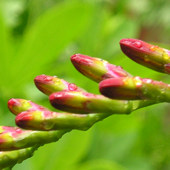28 July 2001
The UK is basking in a heatwave. We're all feeling jolly and men are
wandering about in shorts at 11 o'clock at night. A rare sighting in these
parts.
This week I have been mostly looking at . . .
Nasturtiums
Fabulous things, the way they sprawl about in a glorious blaze of hot colour. I've now at last adjusted to the fact that this year's 'Empress of India' aren't the same shade of red as last year's. Thompson and Morgan and Unwins have different ideas about this variety of nasturtium and what colour it should be, obviously. What I thought would be a deep red is more an orangey red . . . still, they look good, and are now joined by a few apricot coloured nasturtiums.
Heleniums
- and the way the petals emerge from the centre of the flower, extending
outwards. I've never grown Heleniums before, and thought there may be
something wrong with mine, as these flowers appeared, apparently deformed,
with centres, but no petals. Possibly other flowers develop this way,
but I've never noticed it before, most flowers of this kind of shape appearing
to open from a green bud, in a more conventional manner.
Photo of Helenium 'Moerheim Beauty'
Birdlife
In the last week the blackbirds
have been rioting in the Morello cherry tree, as the cherries turn red
and attract their attention. They show great enthusiasm for the ripening
fruit, and several of them can be seen swaying about in the branches,
feasting on the cherries.
This prompted us to pick some ourselves, and picking the fruit prompted
me to climb the tree, which then prompted me to prune it. (Probably badly.)
23 July 2001
Summer disappeared for a while after I described the perfect weather
we'd experienced here in Yorkshire in the first week of the month. Now
the sunshine has returned, and the bees are buzzing happily.
After leaving the garden to settle into summer exuberance and disarray,
in the last week I've put some effort into the kind of maintenance work
that seems important in a small and busy garden like mine. Investigating
the beds revealed a few plants were suffering from the competition.
I've had to rein in the growth habit of some of the floppier plants, some
of which were staked and propped up earlier, but obviously not enough,
as they've since flopped over their neighbours. Plants which are flowering
I've tried to support artfully and as invisibly as possible. Other plants,
such as hardy geraniums which have finished flowering, can have some of
their foliage trimmed back.
There are now a few gaps in my flowerbeds, and in these I place some of
the many pots that otherwise sit on the paved
areas. Again, container plants prove how usefully portable they are. In
summer the paved parts of the garden are needed for seating areas, and
so pots can get in the way. Using them to fill gaps in the borders is
a good solution.
Stars of the moment are:
Jasmine
Smelling jasmine flowers must be up there in the top ten of life's great experiences. Particularly in my garden, where the jasmine sulked unflowering for a few years after being moved from our previous yard garden. Last year it flowered beautifully, and is doing so again this year. Again I'm shown that patience is a virtue . . .
Veronica longifolia
I bought three small plants of this in 1999 after seeing it flowering gloriously at the Helmsley Walled Garden, North Yorkshire. My three small plants had to be cosseted over the winter, then after planting they spread thuggishly and developed into huge clumps of strong foliage and flower. This year one clump has turned itself into a focal point, with its spires of beautiful blue, loved by bees, and by me, as I fight my way past it.
Helenium
I wanted the helenium variety 'Moerheim Beauty' for a year or two before I got around to buying one, and I wasn't mistaken in my coveting of it. It's flowering now, along with another helenium called 'Butterpat' (which is yellow, as you may have guessed). They are both lovely, but 'Moerheim Beauty' is fabulous, and is nicely set off by the rusty iron ball sculpture I have in that flowerbed, as the flower itself is a 'rusty' kind of colour.
Regal lilies
Just wonderfully decadent, scenting every space, elegantly poised at various places in the garden. (I just guessed at the placing of them - but they have natural 'poise'.)
Bird life
The young blackbird chick has only short tail feathers, but is already
up in the trees. It developed so rapidly and moved from the ground so
quickly I didn't see it for a day or two, and thought it had maybe met
an untimely end . . . but was pleased to see it bombing about the garden
with the other, older birds, at least one of which also came from a nest
in this garden.
So though my garden is becoming slightly dishevelled and wild, and hangs
over the wall into the street a little too much, I can justify its increasing
messiness by saying that it seems to become more wildlife friendly every
year.
7 July 2001
Suddenly everything has turned colourful, and hot, dry weather has lasted
for so many days we've relaxed at last into summer.
It's Wimbledon fortnight down in the south. Up here in the north of England,
as the sun sets on another hot day, a neighbour's child is playing with
a tennis ball out in the street. I'm in the garden watching the last sunlight
of today glowing in the branches of the apple tree, and the tall purple
Malva sylvestris (ssp. mauritiana 'Bibor Felho') beside it.
Everything is heat-soaked, dry. The garden achieves its summer fullness,
and flops contented, plants flowering or preparing to flower. There's
no sound apart from the lazy thud of the tennis ball, and nothing to do
except stand here and look . . .
We gardeners of course have to devote a certain amount of time to watering
the garden daily in this kind of weather. Getting the hosepipe out this
year, I realised that it seems shorter than it was, and doesn't reach
the end of the garden. I think I chopped off a length of it to use in
one of my rather unsuccessful water features.
I did set up a half-hearted leaky hose system, but was constantly damaging
the hose while digging or forking over the soil, so that I suspect it
now has far more holes in it that it's supposed to, and probably loses
all its water in its first few metres.
The garden has many flowers now, too many things to mention. The green
of abundant foliage covers walls and hangs in curtains from archways,
and fills all available ground. The garden this summer is different. All
previous years here the garden has been carefully planned, with planting
plans designed to maximise effects of colour and shape.
In the first couple of years I was meticulous about this. In the following
years I've relaxed into my garden, worried about it less, let it form
itself more as it likes. This year it looks, at the height of summer,
fairly disheveled. I don't mind this. I don't try so hard now for perfection
. . .
The peony has finished flowering
now, after its brief annual glory. Its new petals are the texture of silk,
in the most perfect pink imaginable. Once open, the heavy heads of bloom
fade to a paler pink, and flop in a opulent and decadent fashion, not
lasting long before their petals crumple and fall.
A star of this central area now, in the first week of July, is a group
of tall purple Malva sylvestris, grown from seed last year. I had one
unplanned plant, in the summer of 1999, that grew from a packet of mixed
seed I had, and surprised me as it shot up to a great height, and produced
an impressive spire of flower.
I had to identify it and find the seed to grow it again for this year,
as last year the middle of the garden looked a bit feeble - too many pastel
colours, from the Allium christophii
and the hardy geraniums. I needed something a bit more dramatic, and the
Malva is certainly that.
I've a weakness for delphiniums,
though they are possibly too much bother, and, like the peony, take up
too much room for their short flowering season. Still, they're brilliant
mingled with other plants in blue and pink and purple shades in the middle
of my garden, even when they don't stand up straight, but flop about a
little. I particularly like 'Black Knight' - a very deep blue/purple.
The other sunny area is planted with 'hot' colours, reds and yellows.
This is intended to look at its best when the middle area has gone past
its June-early July peak, and though some of the plants in it are beginning
to flower now, it won't look really good until August.
By August the middle area will be full of the drying flowerheads of alliums,
remaining beautiful even as they fade.
At the further points of the garden - 'Woodland
corner' at the far end, and 'Kitchen
corner' near the house, there's mainly green foliage, and very little
flower. These areas are just as pleasing to me as the sunnier parts full
of flower.
The most satisfying thing about summer's height is that the climbers and
the trees, now full of leaf, obscure the boundaries. In winter the ugly
poster hoardings over the road are visible above the wall separating us
from the street, and there are too many visible overlooking windows. The
climbing plants on the boundaries - golden hop, jasmine, roses, clematis,
and ivy - all climb upwards now and fill the spaces, and obscure what
lies beyond them.
The arums look as if this
year, for the first time, they'll form their orange
berries for autumn. Their leaves have died back now, and in the raised
bed near the house the plant has left behind it a stiff little stalk with
tightly packed berries forming, still green.


